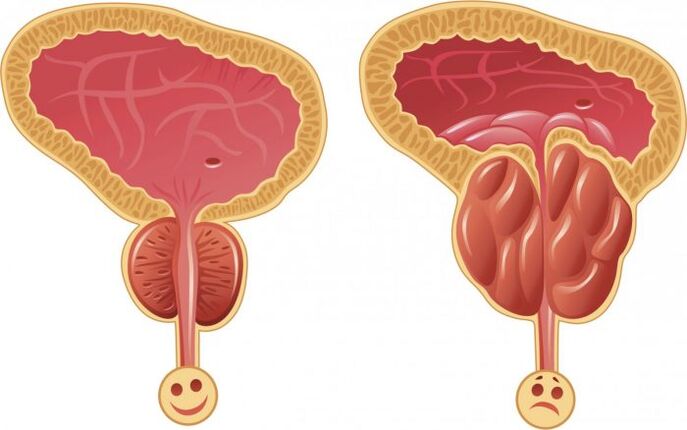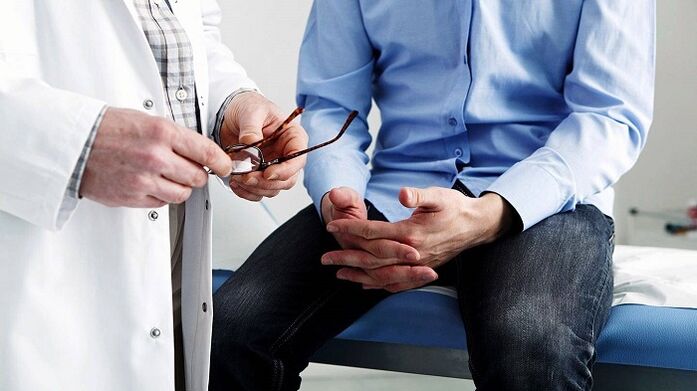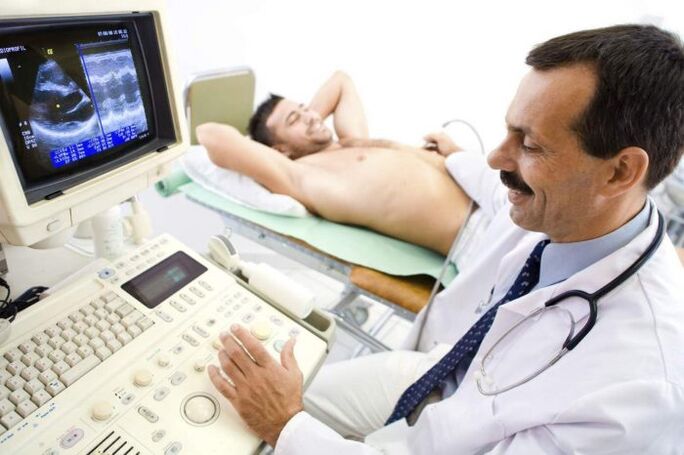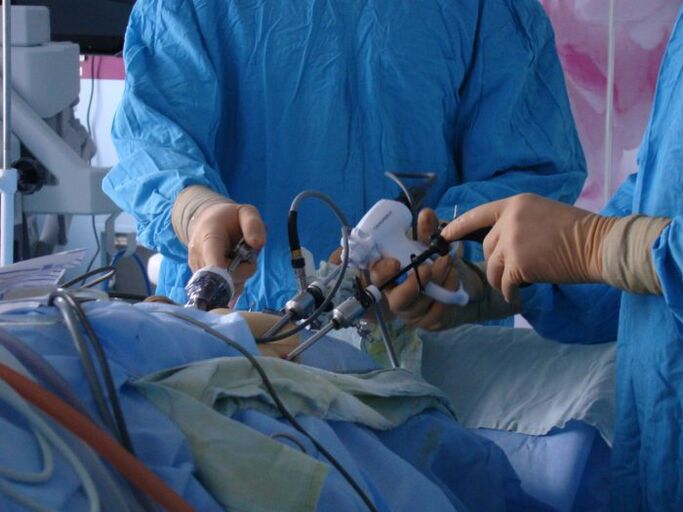Pain when urinating, a burning sensation in the urethra, erection problems, and frequent bowel movements are all symptoms of an inflammatory process in the prostate gland. What is prostatic disease? The disease is multifactorial, caused by a combination of provoking factors leading to inflammation. In medical practice, pathology is classified according to the process, pathogenesis, and other aspects. Let's look at what causes the disease, its symptoms, and how to treat it.
What is prostatic disease?

To understand what prostatitis in men is, you need to know what a glandular organ is. The prostate gland is a male internal organ. In appearance, it resembles "heart" or "chestnut". Ancient doctors called this organ the "second heart of men".
The functions of the gland are as follows:
- Producing bile, which is a liquid with a characteristic odor;
- Protect the prostate gland from infection;
- Maintain adequate erectile function;
- Synthesize the hormone testosterone;
- Make sure urination is normal.
The production of secretions in the prostate gland is observed continuously. In healthy representatives of the stronger sex, it enters the urethra during spermatogenesis. The prostate gland secretes to increase the volume of semen, which contributes to the maintenance of sperm's vital activity.
For your information, prostatitis is a common disease diagnosed in 80% of men, of which 30% are diagnosed between the ages of 20-40 years. According to static studies, pathology is observed in every tenth man.
If the ultrasound examination shows that the prostate is swollen and there is inflammation in it, then this is prostatitis. In most clinical pictures, inflammation occurs with stone formation. The male organ is surrounded by the urethral and vas deferens, edema leads to compression of the ureter. As a result, the main symptoms of the disease are revealed - problems with urination - pain, cramps, burning.
When the inflammatory process occurs, the qualitative and quantitative composition of gastric juice changes, as a result of which libido decreases, erection becomes worse, potency decreases.
Causes and symptoms of prostatitis

When it comes to prostatitis, it is impossible to name the exact cause of the inflammatory process. Many doctors agree that the cause is based on a combination of several factors.
The occurrence of prostatitis is due to the following causes:
- Infectious diseases are transmitted during intercourse.
- Violation of blood circulation in the pelvic organs. This leads to a sedentary lifestyle, wearing underwear and jeans that are too tight.
- Damage to the organs in the perineum, causing poor blood circulation.
- Frequent hypothermia, the presence of chronic pathologies of the reproductive system.
- Hormonal imbalance, erratic sex life, prolonged abstinence.
- Proctitis can provoke the development of prostatitis.
- Constipation of a chronic nature.
- Impaired immune status. The main sources include chronic stress, unhealthy eating habits, alcohol consumption, smoking, unbalanced diet.
- Urinary tract infections such as gonorrhea.
In fact, there are many reasons for the onset of the pathological process. Only by establishing predisposing factors can we speak of a favorable prognosis.
Prostatitis is acute and chronic. In the first case, a man's body temperature increased significantly, frequent defecation, accompanied by severe pain syndrome and weak urine flow pressure. Often, such a clinic is associated with a burning sensation in the perineum, a painful sensation in the rectum during a bowel movement.
Worth knowing:With purulent prostatitis and open abscess, there is a mass of pus draining from the urethral canal or rectum.
In the chronic course of the pathology, the symptoms are not pronounced. The patients were diagnosed at the following clinic:
- Mild fever, which does not subside for a long time;
- Pain in the pubic area;
- Problems with bowel movements;
- Constant fatigue, gratuitous stress and irritability.
Difficulty urinating is a particular danger against the background of inflammation in the glandular organ. In the absence of adequate treatment, it can lead to serious consequences - acute urinary retention.
Types of Prostatitis

So, to learn everything about prostatitis in men, you need to look at the form of the disease. First of all, there is an acute and chronic inflammatory process. The name "form" speaks for itself. This suggests that there is an inflammatory process due to infection. In most cases, microorganisms, often less the simplest microorganisms or fungi.
In the absence of treatment for an acute form of pathology, it is transformed into a chronic process, which can cause a complication in the form of benign hyperplasia of the glandular organ. The symptoms are not profoundly expressed, which is the danger of this type of disease.
The etiology of chronic prostatitis is caused by pathogenic microorganisms and other causes. Examples include stagnation in the pelvic organs, age-related changes.
Important:Bacterial prostatitis is acute and chronic. Bacterial inflammation - Escherichia coli and Pseudomonas aeruginosa, enterococci, Klebsiella. Usually, this type is diagnosed in men aged 20 to 40 years, in association with other types of prostatitis, it occurs in 5-10% of the clinical picture.
Other types of inflammation in the prostate:
- The prostatitis form is characterized by an inflammatory process that develops due to the formation of stones in the prostate gland. Most often, it is diagnosed in patients of the elderly age group who have skipped drug therapy in the acute form. A pox disease leads to impaired reproductive function, infertility, impotence, adenomas and other complications.
- Stagnant disease usually develops in chronic form, non-infectious etiology. The main cause is blood stagnation in the pelvic organs, for example, in the case of decreased blood circulation in the pelvis or stagnant prostate secretions due to irregular activities.
- An infectious disease that develops due to the activity of pathogenic bacteria, in most images the test detects E. coli. There is an acute and chronic course, the clinic is similar to bacterial species.
- Purulent form is the most dangerous type of pathology. In medicine, purulent prostatitis is classified into other types. Catarrhal develops against the background of poor immune status along with progression of pharyngitis and influenza. Cystic prostatitis is already the second stage of purulent disease; There is a purulent discharge into the prostate gland, accompanied by a syndrome of severe pain and high body temperature. Parenchymal form is a severe form that requires prompt treatment. With an abscess of the tissues of the glandular organ, they talk about an abscess; Therapy should be started immediately, because of the risk of sepsis.
The treatment regimens for prostatitis due to a particular type of corresponding pathology can vary considerably. You can combine medication with physical therapy procedures and alternative therapies.
Diagnosis of prostatitis

To diagnose inflammation, the doctor collects the patient's history, then prescribes laboratory and instrumental studies. They allow, on the basis of certain indicators, to make an error-free diagnosis.
Reality:You may suspect prostatitis on a rectal exam of your prostate. Pre-rectal pain and increased organ size are characteristic signs of inflammation.
After palpation of the rectum, the following diagnostic methods are prescribed:
- Ultrasound examination reveals the size of the organ, symptoms of the inflammatory process, changes in the structure of soft tissues;
- The study of the secreted prostate allows you to determine its composition and deviations from the norm;
- Urine study and a smear from the mucous membrane of the urethra will help to identify infectious diseases that are transmitted during sexual intercourse;
- Evaluation of hormonal status. An excess of hormonal substances can lead to pathological proliferation of the tissues of the glandular organ, and a decrease in the concentration of hormones can lead to its activity.
In the diagnosis of the medical professional, it is not the inflammation itself that is of interest, since it can be detected by palpation of the prostate gland, but the causes of the disease. After all, identifying the right trigger allows you to prescribe an effective course of treatment.
Methods of treating diseases

Treatment of prostatitis is always a complex process that involves taking various medications. It is not allowed to use traditional methods of therapy with the permission of a doctor.
Therapeutic activities include:
- Antibacterials, immunostimulating drugs, anti-inflammatory drugs. Dosage, frequency and duration of use are determined individually. Medicines can be purchased at pharmacies, many require a doctor's prescription.
- Physiotherapy manipulations - use of magnetic fields, leech therapy, ultrasound and laser treatment.
- Prostate massage. It allows you to strengthen the reproductive system, normalize blood circulation in the prostate and pelvic organs.
Traditional treatments include decoctions and infusions based on medicinal herbs. Patient reviews note a high therapeutic effect of red rhizome, licorice and marshmallow.
Important:To cure prostatitis, you must strictly follow the prescribed treatment regimen. Self-administration of drugs, even the most effective ones, may not bring the desired results. There is no single therapeutic tactic: what helps one patient harms the second.
Preventive action
Prostatitis is one of the more preventable diseases. Doctors have long developed preventive measures to eliminate this disease. Prevention is primary and secondary. In the second case, it is meant to prevent the recurrence of a chronic disease.
Preventive action:
- Physical activity;
- Frequent sex;
- Exclusion of promiscuous sex;
- Timely treatment of all comorbidities;
- Preventive examination by a urologist;
- Proper nutrition, refuse bad eating habits.
Prostatitis prevention does not require much time and investment, the effectiveness of the measures is undeniable.
Prostatitis is a common disease. The rate of self-healing is very low. The lack of adequate therapy leads to a chronic episode, which periodically worsens and can cause visceral hyperplasia or cancer.































